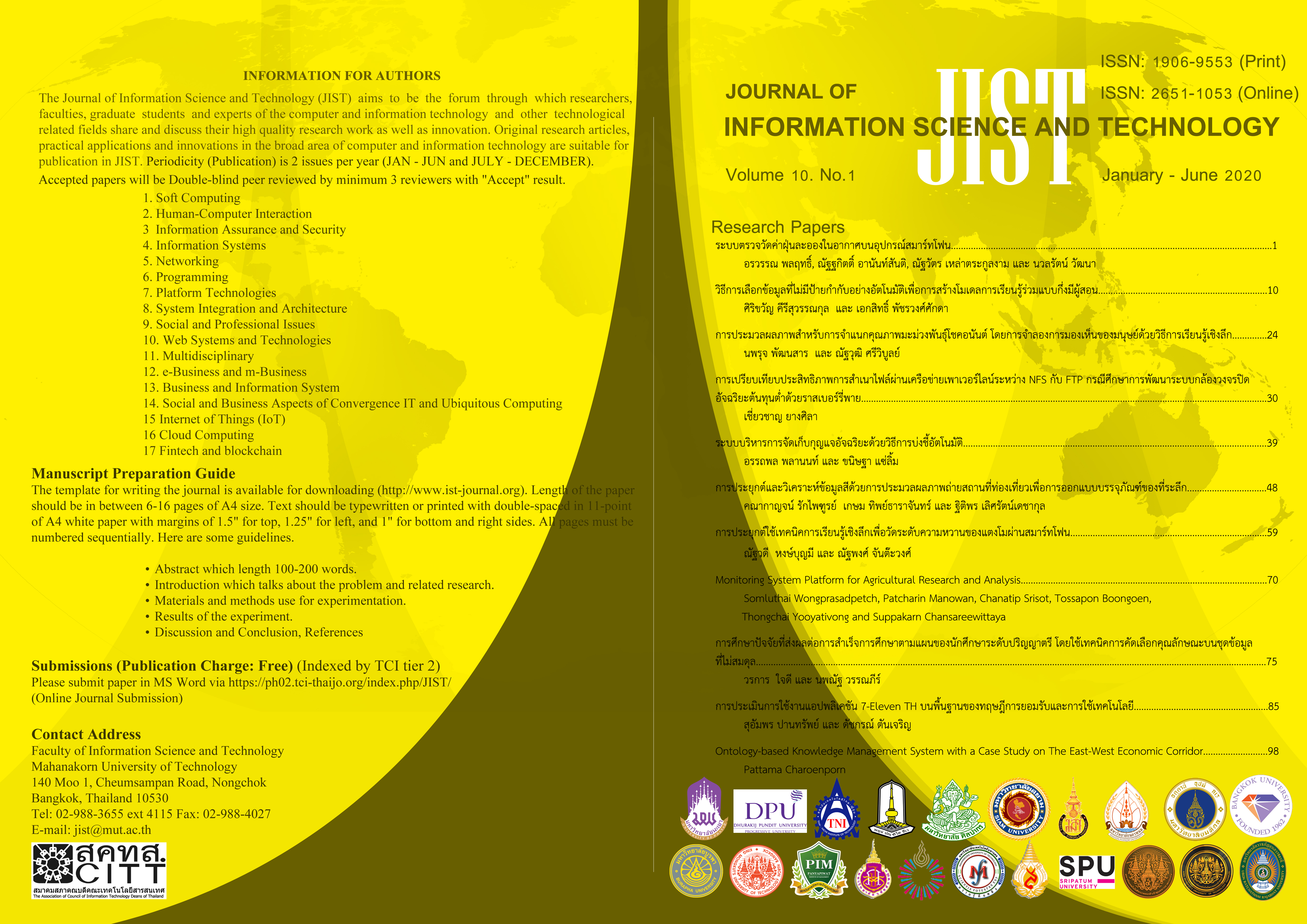Intelligent Key Storage Management System with Automatic Identification
Main Article Content
Abstract
In this paper, we present the intelligent key storage management system by the automatic identification method. The device can store a maximum of 48 room keys. The borrowing key system uses automated biometric identification and a key return system uses an RFID-based automated identification method. These methods can identify the borrowed person and reference the keys of each room with identification tags to store the keys in the box. The operation system is controlled through a program window that can add, edit, and delete keys for each room. In disbursement of the keys for use, users must register to verify their fingerprints to determine the right to use the system. After successfully register in the system, Users can choose a room and borrow the keys with their fingerprints. After that, when the room has been used successfully, the user can return the key to the key return box. The system reads the room number from the identification tag and stores it in the key storage box. In our experiment, we used a questionnaire was used to collect data to survey the satisfaction of 50 users and compared the performance in two parts: measuring user satisfaction and measuring system performance. In the first part, the results of the development of this system showed that they were satisfied with the convenience and ease of use and satisfaction with the data security system and satisfaction with the design and the beauty with an average of 96.133, 88.2, and 78.4, respectively. In the second part, the proposed system compared with the staff. The results of experiments show that the developed system is faster than the staff about 3.681 seconds. In the same direction, the proposed system is faster than the staff in the average time when returning the key about 2.089 seconds.
Article Details
This work is licensed under a Creative Commons Attribution-NonCommercial-NoDerivatives 4.0 International License.
I/we certify that I/we have participated sufficiently in the intellectual content, conception and design of this work or the analysis and interpretation of the data (when applicable), as well as the writing of the manuscript, to take public responsibility for it and have agreed to have my/our name listed as a contributor. I/we believe the manuscript represents valid work. Neither this manuscript nor one with substantially similar content under my/our authorship has been published or is being considered for publication elsewhere, except as described in the covering letter. I/we certify that all the data collected during the study is presented in this manuscript and no data from the study has been or will be published separately. I/we attest that, if requested by the editors, I/we will provide the data/information or will cooperate fully in obtaining and providing the data/information on which the manuscript is based, for examination by the editors or their assignees. Financial interests, direct or indirect, that exist or may be perceived to exist for individual contributors in connection with the content of this paper have been disclosed in the cover letter. Sources of outside support of the project are named in the cover letter.
I/We hereby transfer(s), assign(s), or otherwise convey(s) all copyright ownership, including any and all rights incidental thereto, exclusively to the Journal, in the event that such work is published by the Journal. The Journal shall own the work, including 1) copyright; 2) the right to grant permission to republish the article in whole or in part, with or without fee; 3) the right to produce preprints or reprints and translate into languages other than English for sale or free distribution; and 4) the right to republish the work in a collection of articles in any other mechanical or electronic format.
We give the rights to the corresponding author to make necessary changes as per the request of the journal, do the rest of the correspondence on our behalf and he/she will act as the guarantor for the manuscript on our behalf.
All persons who have made substantial contributions to the work reported in the manuscript, but who are not contributors, are named in the Acknowledgment and have given me/us their written permission to be named. If I/we do not include an Acknowledgment that means I/we have not received substantial contributions from non-contributors and no contributor has been omitted.
References
A.Pavithra, M.Kalavathi, S.Keerthi, and SK.Sabirunnaisa, “Access Control Using RFID and Arduino,” B.Tech. Project Report (Electronics and communication engineering), Jawaharlal Nehru Technological University, Hyderabad, 2013.
Praharshin M. Senadeera, and Numan S. Dogan, “Emerging Applications in RFID Technology,” Inter. J. of Computer Science and Electronics Engineering (IJCSEE), vol. 4, no. 2, pp. 75-79, 2016.
H. F. Abdulsada, “Design and Implementation of Smart Attendance System Based On Raspberry pi,” Journal of Babylon University, Engineering Sciences, vol. 25, no. 5, pp. 1610-1618, 2017.
สุนีรัตน์ อินตะมะ และวันดี มงคงกาย, “ไขความลับ...กับระบบจัดการกุญแจ,” May, 2019. [Online]. Available: https://www.excise.go.th/cs/groups/public/documents/document/mjaw/mdy2/~edisp/webportal16200066805.pdf. [Accessed: May 20, 2019].
E. Michael, Y. Isah, Bako Hussaini, O.F. Hassan, and V.C. Ezika, “Arduino Based RFID Line Switching Using SSR,” Int. J. of Scientific and Technology Research, vol. 6, no. 10, pp.98-100, 2017.
EZ. Orji, CV. Oleka, UI. Nduanya, “Automatic Access Control System using Arduino and RFID,” Journal of Scientific and Engineering Research, vol. 5, no. 4, pp. 333-340, 2018.
พิทย์พิมล ชูรอด, เนาวลักษณ์ แสงสนิท, และสุพิริยา ผลนาค, “การพัฒนาระบบยืมหนังสือด้วยเครื่องสแกนลายนิ้วมือของสำนักหอสมุด มหาวิทยาลัยทักษิณ วิทยาเขตพัทลุง,” วารสารมหาวิทยาลัยทักษิณ, ปีที่ 16, ฉบับที่ 2, กรกฎาคม-ธันวาคม, หน้า 1-8, 2556.
อาจารี นาโค, “การประยุกต์เครื่องอ่านลายนิ้วมือเพื่อตรวจสอบการเข้าชั้นเรียน,” วารสารมหาวิทยาลัยทักษิณ, ปีที่ 16 ฉบับที่ 3 ฉบับพิเศษ, หน้า 11-20, 2556.
K. S. Myint, C.M.M. Nyein, “Fingerprint Based Attendance System Using Arduino,” Int. J. of Scientific and Research Publications, vol. 8, no. 8, July, pp. 422-426, 2018.



